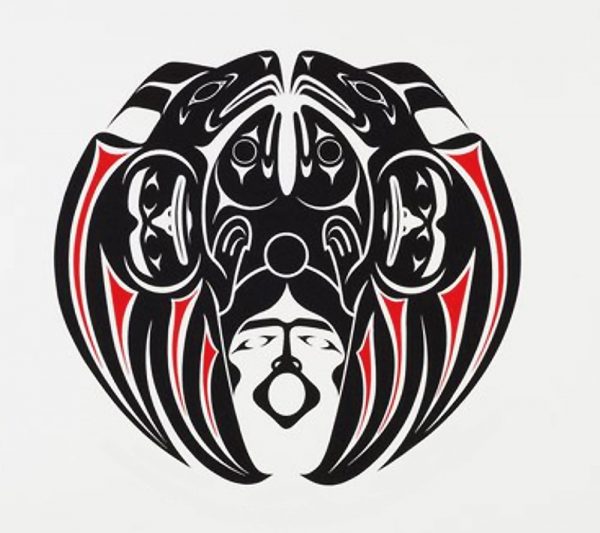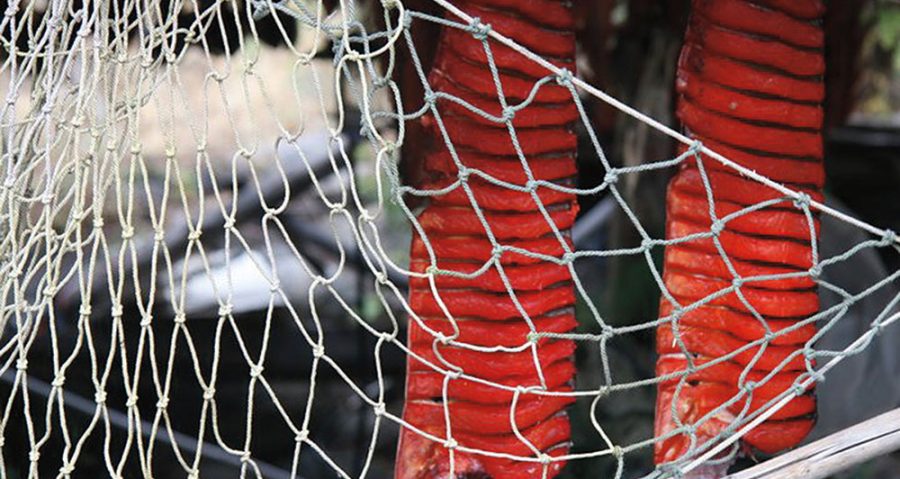Food
Wind, water, forest, livelihood and ceremony — these are all elements united through salmon. In my world- view, shaped by my St’atl’imc, Secwepemc and Dutch ancestry, salmon is central. I grew up climbing all over the many commercial fishing boats that were moored alongside my father’s “floating workshop,” a 30-metre tugboat converted into his place of business for repairing or rebuilding commercial fishing vessels. The seine boat captains that I recollect interacting with were either First Nation or Croatian. The salmon of my childhood was plentiful and easy to access: a quick request made, a gaff hook grabbed and a fibreglass fish hold, full of salmon and ice slurry, opened.

Today, more than 30 years later, to think about salmon is to mourn the bounty that was and the devastation that is when it comes to salmon runs. It’s to reflect on the salmon’s ever- shrinking run size up to its spawning channels and the compounding negative impacts from resource extraction industries, agriculture and urbanization.
Where I currently live, in the northern- most part of Secwepemcúlecw close to Quesnel Lake, the Mount Polley mine disaster of 2014, which sent thousands of tonnes of toxic min- ing waste into Polley Lake, continues to affect salmon stocks, water quality and the environ- ment downstream. The British Columbia First Nations Health Authority conducted a study with First Nations affected by the spill and found that the Xat’sull, T’exelcemc and Lhtako Dené suffered immediate and ongoing impacts to traditional territory, foods and medicines. Community members, worried about contamination, have reduced all fishing. The full impact of the spill remains unknown but is alarming enough that Amnesty International Canada has brought an international focus to it and the United Nations Working Group on Business and Human Rights visited the area in 2017.
For me, salmon is not just a protein in the routine meal plan, though most nutritionists would be quick to tell you of the many benefits of including salmon in your diet. Salmon is a feast food, a culinary marker of ceremony, be it in celebration of life, a loss, or a naming. To prepare for hosting a feast means digging around in the freezer to see how many precious salmon there are and checking how many jars of home-canned salmon are stashed in the pantry.

How to explain the value of salmon? When far from home, to receive a care package of ts’wan (wind-dried salmon) can dash away the deepest case of homesickness. I remember a thoughtful friend sending me off to Europe for a school exchange with international phone cards and a bag full of dried salmon. Each piece was carefully meted out, saved for whenever the strangeness of the land or culture would start to overwhelm me. When visiting a First Nation community, to receive a jar or — gasp — a case, of home-smoked and canned salmon is a gift to be dearly cherished and shared with extended family back at the home fire.
Salmon is so central to my world it even unites my close friends. For 20 years, Xat’sull community member and engager Cheryl Chapman has been involved in the Save-the- Salmon Traditional Powwow, where dancers have danced near the salmon spawning channels in Horsefly, B.C. Lately, they have also danced by the Fraser River near four Xat’sull fishing rocks for dip net fishing — part of the Xat’sūll Heritage Village. This tourism attraction is another place dear to Cheryl’s heart, where she has dedicated much of her time and energy. She loves having visitors interact with her family Elders, learning their history first-hand as well as enjoying s’qelsém feasts with traditionally pit-cooked salmon and root vegetables. She works with Mother Earth, fire and “grand- father lava rocks” to create the “original slow cooker”— the ultimate experience for the slow food movement.
For me, salmon is not just a protein in the routine meal plan.
Another dear friend, Sunny LeBourdais, has worked with her family to give others a glimpse into the world of dip net fishing through her family’s connection to their fishing rock, located along the Fraser River close to Kelly Creek. An ecologist, educator and community builder, Sunny is passionate about safeguarding her family’s role as “Yucwminmen te Secwepemcúlecw” — caretakers and stewards of their area for the benefit of the Secwepemc Nation. Through the People of the White Earth Society (Pelltíq’t te Secwepemc), she and her family published Our Fishing Journey, an award-winning iBook about their fishing spot.
When I visit First Nations around British Columbia, we may bicker about what salmon run is the best or which cooking or smoking methods yield the tastiest results, but we will always agree that salmon is central to our feasts and ceremonies. And, if I am fortunate, I may just hear their version of how salmon was brought to their territory through one of their “tellings.” If you happen to find yourself in Secwepemcúlecw, I encourage you to keep your ear cocked for the chance to hear the oral telling of “Coyote and Salmon,” which is imbued both with teachings and some of our Secwepemc laws. May that experience bring you a little bit closer to valuing our salmon as we do.

Order now
from Amazon.ca or Chapters.Indigo.ca or contact your favourite bookseller or educational wholesaler




